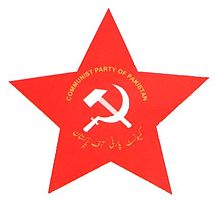- Communist Party of Pakistan
-
Communist Party of Pakistan
کمیونسٹ پارٹی آف پاکستانSecretary-General Tanvir Ahmad Khan Founder Sajjad Zaheer
Manabendra Nath RoyFounded March 6, 1948 Split from Communist Party of India Preceded by CP Banglagesh
Communist Proletariat Party
CPP (Thaheem Faction)Headquarters D-16
Naseem Nagar Phase-III
Hyderabad, PakistanNewspaper Baghawat Ideology Communism, Marxism-Leninism International affiliation International Conference of Communist and Workers' Parties Official colors red Website http://www.cppak.org The Communist Party of Pakistan (Urdu: کمیونسٹ پارٹی آف پاکستان; Russian: Коммунистическая партия Пакистана, Kommunisticheskaya partiya Pakistan; Short КПП, KPP) is a communist party affiliated with Communist Party of the Russia. Before the disintegration of the Soviet Union, the party had long association and ties with the Communist Party of the Soviet Union (CPSU).
The CPP was founded in Calcutta, Union of India on March 6, 1948. A decision was taken at the Second All India Conference of the Communist Party of India, which was held in Calcutta at that time, that a separate communist party ought to be created in the new state of Pakistan. It was thought that Pakistan, being a relatively small country (in comparison to India) and suffering from instability, was ripe for revolution. The delegates from Pakistan separated themselves and held a separate session were they constituted the CPP. Sajjad Zaheer (founder of the All India Progressive Writers Association), from West Pakistan, was elected General Secretary. The delegates from East Pakistan elected an East Pakistan Provincial Committee. Many Muslim leaders of the CPI were sent to Pakistan to help with the formation of the party.
The attempt to start a revolution in Pakistan failed and the CPP leaders were jailed. In the 1951 Rawalpindi Conspiracy Case, many leading members were convicted and the party was forcibly repressed by successive governments.[1]
Diplomatic intervention by Nehru led to the most prominent CPP leaders being freed and sent back to India. At this stage the CPP was in poor shape in West Pakistan, while in East Pakistan the party had a limited foundation. However, it was difficult to have a unified underground political organization spanning such a vast geographical territory and the East Pakistan branch was able to operate with autonomy.
In the provincial elections in East Pakistan in 1954, the CPP supported the United Front launched by the Awami League, Krishak Sramik Party and the Nizam-e-Islam Party. Four out of ten CPP candidates were elected, and 23 CPP members were elected as candidates of other parties. In total, the front won 223 seats out of 310.
In 1954 the party and CPP front organizations such as the National Students Federation, Progressive Writers' Movement and Railway Worker’s Union were banned. After being banned, CPP launched the Azad Pakistan Party with Mian Iftikhar-ud-Din as leader in West Pakistan. In 1957, the CPP and other leftists created the National Awami Party as a legal party. The APP merged into the NAP.
In East Pakistan, the CPP worked within the Awami League and then in Ganatantri Dal.
In 1958 the Kull Pakistan Kissan Association (All Pakistan Peasants Association) was launched.
In the mid-1960s the US State Department estimated the party membership to be approximately 3000.[2] The CPP also began to organize themselves abroad. In Europe, the CPP branch published the Urdu magazine Baghawat, which translates as "rebellion".
In 1966 the Sino-Soviet split reached the CPP. In East Pakistan a pro-Chinese group broke away from the CPP. In 1970 the Mazdoor Kisan Party broke away in West Pakistan.
At the fourth party congress in Dhaka in 1968, a decision was taken that a separate communist party should be formed for East Pakistan. Thus the Communist Party of East Pakistan (CPEP) was founded. The CPEP later became the Communist Party of Bangladesh.
The CPP organized a militant and armed peasants struggle in Patfeeder, Baluchistan. The CPP resisted the autocratic regimes of the times, and built up militant trade union movements.
In December 1990 Jam Saqi became general secretary of the party. In April 1991, he resigned from the party.[3]
In 1995 the CPP merged with the Mazdoor Kissan Party to form the Communist Mazdoor Kisan Party. The CPP accepted the criticism that they had been too uncritical towards the Soviet Union. In 1999 a group broke away and reconstituted the CPP. In 2002, the CPP split, leading to the existence of two separate CPPs, one led by Maula Bux Khaskheli and a splinter-group led by Khadim Thaheem.
Comrade Tanveer Ahmad Khan is the Punjab Secretary of the party and Punjab office is located in Lahore which has been publishing Surkh Parcham, the party's organ for a longer time and is responsible for many Marxist publications.
See also
References
- ^ http://www.laborpakistan.org/leftmovement.php
- ^ Benjamin, Roger W.; Kautsky, John H.. Communism and Economic Development, in The American Political Science Review, Vol. 62, No. 1. (Mar., 1968), pp. 122.
- ^ Pakistan Christian Post
External links
Categories:- Communist parties in Pakistan
- Political parties in Pakistan
- Political parties established in 1948
- Communist parties in Bangladesh
- Pakistan–Soviet Union relations
- Social movements in Pakistan
- Secularism in Pakistan
Wikimedia Foundation. 2010.


